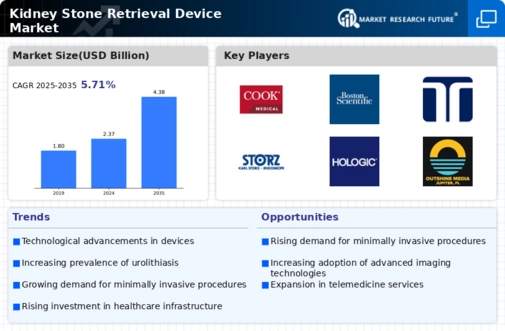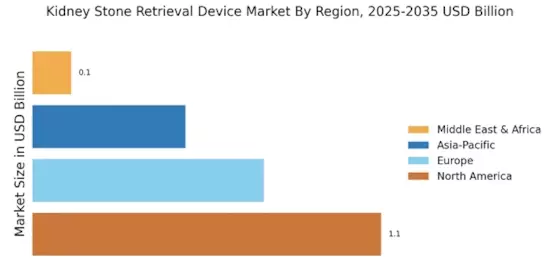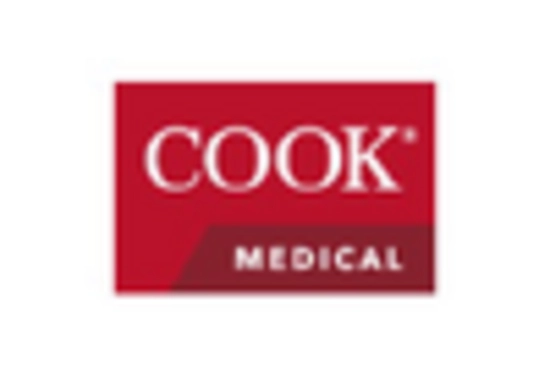Focus on Outpatient Procedures
The Kidney Stone Retrieval Device Market is witnessing a marked shift towards outpatient procedures, driven by advancements in medical technology and changing patient preferences. Patients increasingly favor minimally invasive treatments that allow for quicker recovery and reduced hospital stays. This trend is reflected in the growing adoption of outpatient facilities, which are becoming more equipped to handle kidney stone retrieval procedures. As a result, the market for kidney stone retrieval devices is likely to expand, with manufacturers focusing on developing products that cater to this outpatient model. The convenience and efficiency of outpatient procedures are expected to enhance patient satisfaction, further propelling the growth of the Kidney Stone Retrieval Device Market.
Increasing Healthcare Expenditure
The Kidney Stone Retrieval Device Market is positively impacted by the increasing healthcare expenditure observed in various regions. As governments and private sectors allocate more funds towards healthcare, there is a corresponding rise in investments in advanced medical technologies, including kidney stone retrieval devices. This trend is particularly evident in developed economies, where healthcare budgets are expanding to accommodate innovative treatment options. The increased financial resources enable healthcare facilities to procure state-of-the-art devices, thereby enhancing their capabilities in treating kidney stones. Consequently, this influx of capital is likely to stimulate growth within the Kidney Stone Retrieval Device Market, as providers seek to improve patient care and operational efficiency.
Rising Incidence of Kidney Stones
The Kidney Stone Retrieval Device Market is significantly influenced by the rising incidence of kidney stones across various demographics. Studies indicate that the prevalence of kidney stones has been increasing, with estimates suggesting that approximately 10% of individuals will experience a kidney stone in their lifetime. This rising trend is attributed to factors such as dietary changes, obesity, and dehydration. As the number of patients requiring treatment for kidney stones grows, the demand for effective retrieval devices is expected to rise correspondingly. This increase in patient volume presents a lucrative opportunity for manufacturers within the Kidney Stone Retrieval Device Market, as healthcare systems seek to equip themselves with the necessary tools to manage this escalating health concern.
Growing Awareness and Education on Kidney Health
The Kidney Stone Retrieval Device Market is benefiting from a growing awareness and education regarding kidney health among the general population. Public health campaigns and educational initiatives are increasingly focusing on the prevention and management of kidney stones, leading to a more informed patient base. As individuals become more aware of the risk factors and symptoms associated with kidney stones, they are more likely to seek medical attention promptly. This proactive approach to kidney health is expected to drive demand for effective retrieval devices, as healthcare providers respond to the needs of an informed patient population. The emphasis on education and awareness is likely to play a crucial role in shaping the future of the Kidney Stone Retrieval Device Market.
Technological Advancements in Kidney Stone Retrieval Devices
The Kidney Stone Retrieval Device Market is experiencing a surge in technological advancements that enhance the efficacy and safety of procedures. Innovations such as laser lithotripsy and advanced endoscopic techniques are revolutionizing the way kidney stones are treated. These technologies not only improve the precision of stone removal but also reduce recovery times for patients. The introduction of minimally invasive devices has led to a notable increase in outpatient procedures, which are projected to account for a significant share of the market. As healthcare providers increasingly adopt these advanced technologies, the Kidney Stone Retrieval Device Market is likely to witness substantial growth, driven by the demand for improved patient outcomes and reduced hospital stays.


















Leave a Comment